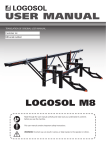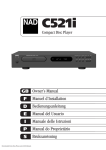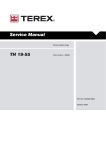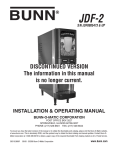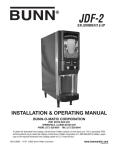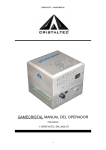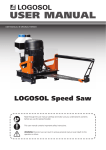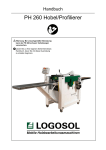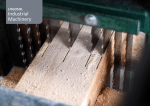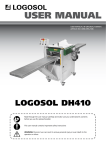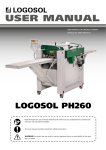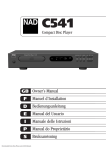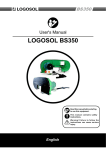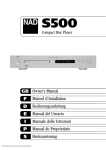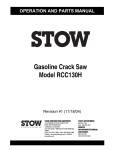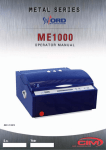Download Farmers m8
Transcript
user manual Translation of original user manual. Customer no: M8 serial number: Farmers m8 Read through the user manual carefully and make sure you understand its contents before you use the machine. This user manual contains important safety instructions. warning! Incorrect use can result in serious or fatal injuries to the operator or others. logosol continuously develops its products. For this reason, we must reserve the right to modify the configuration and design of our products. Document: Farmers m8, user manual manual, part no.: 0458-395-1201 Text: mattias Byström & erik svensson Pictures: mattias Byström, lars Wahlström & erik svensson last revised: march 2014 © 2014 logosol, Härnösand, sweden 2 Farmers m8 Table of contents safety instructions 4 Description of machine 6 Technical data, required tools 7 sawmill components 8 assembly: leg units 9 assembly: sawmill guide rail 10 assembly: struts 11 assembly: guide rail & struts 12 assembly: log support and log bed 13 assembly: saddle plate & latch 14 assembly: latch, crank and lifting line 15 assembly: log holders 16 assembly: saw carriage 16-17 assembly: logosol nuts 17 assembly: chainsaw 18 siting 19 adjustment 20 sawing 23 material Drying 25 Troubleshooting 26 Cutting equipment 29 accessories: Chainsaw carriage m8, assembly 30 accessories: log ladders, extensions and log Clamp Xl 33 eC Declaration of conformity 30 3 safety instructions • Read carefully through the entire manual before starting to operate the Farmers m8. Failure to observe these safety instructions may result in fatal injuries. • make sure that everyone who uses the sawmill is well informed of the dangers and has read the manual. The manual must also be available to everyone who uses the sawmill. This also applies where the sawmill is sold or loaned out. • Read the manual and safety rules for the sawing unit used on the sawmill. • minors under 18 years of age should not be allowed to operate the logosol sawmill. • make sure that children and animals are not in the vicinity when the sawmill is being operated. • • • • • 4 The Farmers m8 is a one-person machine. Respect the safety distances to avoid injury from high noise levels and from chain thrown-off in the direction of the guide bar if the chain breaks. anyone working with the sawmill must be fit for work, healthy and in good physical condition. make sure you take regular breaks when operating the machine. never operate the machine while under the influence of alcohol, narcotics or other drugs or medicines that can cause drowsiness or in-attention. The Farmers m8 is only to be operated where visibility is good. It is not to be operated in the dark or where visibility is poor. never work alone and make sure there are other persons within earshot who you can summon if you need help. only add extra equipment to the sawmill that is made by logosol or that is specifically approved by logosol for the purpose. other equipment can cause accidents and should not be used. logosol will not accept liability for personal injury or material damage incurred while using non-approved attachments on the sawmill. • support legs must be fitted under the guide rail ends where the sawing unit weighs more than 15 kg. Risk of overturning! • always wear protective clothing and use personal protective equipment: Close-fitting work overalls are appropriate. never operate the unit wearing loose-fitting clothes, overall coats or similar. • use safety shoes with high-grip soles and steel toecaps. neckerchiefs, ties, jewellery or other items that can get caught in the equipment are not to be worn. • never stretch over or under the logosol sawmill’s guide rail when the sawmill is in operation. Rotating cutting equipment. Risk of cut injuries! • Wear strong protective gloves. Risk of cut injuries when handling the guide bar and the saw chain. Cutting equipment can also be hot immediately after sawing. Remember that hearing can be damaged after relatively short periods of exposure to the high frequency noise of the motor and the cutting equipment. Key To symboLs For your own safety, read through the entire user manual carefully and do not start the machine before you have understood everything. use approved ear protectors and protective eyewear. Hearing can be damaged even after short periods of exposure sharp rotating tools. make sure that your fingers never are in or move into the vicinity of the cutter. This symbol means ’WaRnIng’. Pay particular attention where this symbol appears in the manual text. a warning comes after this symbol. Pay particular attention where this symbol appears in the manual text. FARMERS M8 sAFe DIsTANCes Respect the safe distances. The safe distance is 8 m for the operator or 15 m for persons other than the operator. The picture below shows the logosol sawmill from above. The operator is to remain within the area marked with a dashed line (- - - -) when the saw is in operation. The operator is not to stretch over the line when operating the unit. • DurINg operATIoN: The sawmill is not to be in any other position than level when in operation. Risk of overturning! The logosol sawmill should be fastened directly to the floor or be placed on a bedding of planks which increases the area of the load bearing surface (see manual). • • Tighten the tank cap as tightly as possible, to minimise the risk that the cap vibrates loose during sawing. • never saw with the chainsaw throttle locked. always operate the throttle manually when sawing. Increased throw-out risk! never use rip sharpened chain when cutting. Hold the crank firmly whenever raising or lower- ing a log. If released, the crank may spin back and hit your hand hard. Do not place your hand on the inside of the long leg when raising or lowering the log. There is a risk that your hand can be trapped if the lifting line snaps or the crank spins. The operator’s position during operation. WheN usINg peTroL A DrIveN ChAINsAW: Fire risk. Turn off the engine before refuelling. Petrol is extremely inflammable. Burn injuries can be life threatening. If you spill fuel, immediately clean the components the fuel has come in contact with. Clothes on which fuel has been spilt are to be changed immediately. assembled. Risk of chain breaks! Check that saw unit is pushed fully into position on the guide rail. Throw-out risk on start up! • logs must always be rolled on to the sawmill level with the horizontal beam. never lift logs from ground level directly up onto the sawmill. There is a risk of damage if the log drops or if the sawmill overturns! • Do not saw short logs that do not extend more than 0.2 m beyond each log bed. a shorter log can fall off when the log beds are raised! • The maximum permitted load for the sawmill is 500 kg. extensions increase the maximum load by 250 kg for each leg unit with lifting unit. always stand to the right of the saw unit when it is in operation. Chains or bands that break can be thrown out through the chip outlet. • Keep the worksite free of tools, pieces of wood, chips and other items you can trip on. beFore eACh WorK perIoD: • Check the lifting line’s condition in particular. Change immediately any sign of wear is detect- ed. Check that bolted joints and locks in the log bed lift and lock system are fully tightened and that all the sawmill moving parts move freely and smoothly. • Check that the sawmill is completely level and that it is securely fixed to the underlying surface. Risk of overturning! • Check that the cutting equipment is correctly Turn the chainsaw off after each cut. never leave the logosol sawmill unattended such that unauthorized persons can start it Stop sawing immediately and turn off the chainsaw, if any problem occurs, until it has been resolved. Always keep this in mind. most accidents with dangerous machines, both Logosol sawmills and other machines, happen when something goes wrong and the operator attempts to fix it while the machine is still running. A stop seldom shows up on the finished product. 5 description of machine • • • • • • many of the aluminium components are anodized and completely rustproof. The outer surface is as wear resistant as tempered steel, has a low friction coefficient and is easy to keep free of resin and chips. adjustable feet make it easy to compensate for uneven surfaces. Clear scales show the height of the log bed. extra measuring rods are available as accessories to show sawing height settings. The crank axle runs through maintenance-free bronze bearings that do not wear out. The slide rails use low-friction plastic that has a long lifetime thanks to the fine surface of the guide rail. The settings for sawing parallel to the grain of conical logs are quick and simple to set.(The log beds can be set at different heights so that more than half of the cuts give acceptable yields.) many accessories for the m5 and m8 also can be used with the Farmers m8. mAINTeNANCe The Farmers m8 should be kept clean, and all plastic parts should be lubricated with logosol’s lubricant (7500-001-5050) or silicone lubricant (7500- 0015067). Regularly check the condition of the lifting lines. The tempered ratchet bar is only lightly protected against rust and should be kept coated with a thin layer of superflo (999-000-5115) to prevent rust. servICe The sawmill must be inspected regularly and maintained as needed. only carry out the maintenance and repairs specified in the manual. other repairs must be carried out by logosol or by authorized logosol dealers. Do not make any alterations to the construction of the sawmill as this can increase the risk of accidents. after service, the Farmers m8 should be in its original condition. logosol accepts no liability for damage that occurs while working on an improperly modified machine. 6 AssembLy The Farmers m8 is designed for simple assembly and adjustment. set up on an underlying surface which does not scratch the surface treatment during assembly. save time by reading through the entire assembly instruction before assembly is begun and then follow the instructions step by step. When this symbol appears, tighten the fasteners so that they still can move. When there is no symbol, tighten the bolts well. FARMERS M8 required tools (Tools are not supplied with the sawmill.) • • • • • • • Ring or flexible head spanner 10 mm Ring or flexible head spanner 13 mm Ring or flexible head spanner 17 mm Ring or flexible head spanner 16 mm allen key 4 mm allen key 8 mm set square 2 pieces 1 piece 1 piece 1 piece 1 piece 1 piece 1 piece a battery-driven drill or screwdriver with a 10 mm hexagon socket and a ratchet key with 10 and 13 mm hexagon sockets will make assembly easier. technical data length: 4.0m. Width: 0.7m Width of log bed: 0.5m Weight: 52 kg Weight with carriage for chainsaw: 53 kg max. rec. log diameter: 0.6m max. rec. log length, standard version: 3.5 m max. log weight: 500 kg 7 saWmill components Below is a brief description of the Farmers m8 components to assist in identifying them during assembly. Left Operator side 1 Right 11 5 9 6 10 2 7 4 8 1 2 3 4 5 6 7 8 9 10 11 12 13 14 15 16 17 18 19 8 guide rail Joint coupler long leg Horizontal beam short leg guide rail strut Brace plate log bed log holder with log clamp Foot log support Knee connector Carriage lifting beam Ratchet bar Ratchet bar stop plate saddle plate Ratchet cam Ratchet cam axle Crank lockring lockring with line attachment Plastic slide rail on log bed Indicator line pulley 18 17 3 16 12 13 15 19 FARMERS M8 assembly: leG unit 1 4 2 3 The right and left leg units are assembled in the same way. The bolts listed below are for one leg unit. (1) Fit the horizontal beam to the short leg. Be careful not to damage the bevelled faces before assembly. note that the m6 washers should be placed under the inner knee. (8 x m6x20 hex bolts, 8 x m6 collar nuts, 8 st m6 brickor) (2) Fit the horizontal beam to the long leg. (4 x m6x20 collar bolts, 4 x m6 collar locking nuts) adjust so that the angle is at exactly 90° between the horizontal beam and the long leg. Check using a set square. Then tighten the bolts well. (3) Fit the sawmill feet. The slots in the foot and the leg should form a cross. make sure that the foot runs straight in the leg. (4 x m8x25 allen head bolts, 4 x m8 collar locking nuts, 4 x m8 washers) (4) assemble the pulley, see picture. (1x m6 collar nut). note: Your sawmill may have been delivered with bolts and nuts without collars. In that case you can use standard nuts and washers. 9 assembly: saWmill Guide rail oil oil 5 6 3x 8 9 7 work on a level surface. Cut the beam cardboard in half and place the two halves after each other to form an underlay to ensure that the slide surfaces are not scratched. The joint coupler must be turned in the correct direction. see fig. The joint opening must be turned towards the guide rail sliding surface. Coat the sides of the joint coupler with oil. This is important, to ensure that the joint expands in the right way when the bolts are tightened. 10 (5) make sure that the bolts in the joint coupler are loose. They should be loosened approximately one turn from the point at which they begin to tighten. (2 x m8x35 allen head bolts, 2 x m8 nuts) (6) Insert half the joint coupler in one end of the guide rail section so that the allen head bolt is accessible through the hole in the side of the guide rail. Tighten the bolt somewhat. (7) Fit the other guide rail section over the joint coupler and push the sections completely together. If the guide rail cannot be easily pushed onto the joint coupler, this can be because the guide rail parts are not correctly aligned or that a bolt is too tight. (8) Tighten the two allen head bolts. (9) Repeat the same steps with the remaining guide rail sections and joint couplers. FARMERS M8 assembly: struts Type 1 (10) assemble the guide rail struts and the brace plates into finished struts, a total of four, two of each type, according to fig. note the position of the brace plates on the two different types of struts. (4 x m6x16 collar bolts and 4 x m6 collar locking nuts per strut). Type 2 struts and brace plates form a long strut between the long legs. see the next step of the assembly. Fit the bolts in the centre of the oval holes and make sure that the brace plates are aligned with the guide rail strut. The two remaining guide rail 11 assembly: Guide rail & struts 11 Type 1 Type 2 Typ 2 13 12 a Typ 1 a (11) Place the guide rail on the long legs. Press the guide rail downwards against the long legs and tighten the bolts (4 x m6x20 collar bolts, 4 x m6 collar nuts). (12) Fit the long strut, which connects the long legs. start by fitting bolts and nuts (4 x m6x20 collar bolts, 4 x m6 collar nuts) in the long legs (a) and then fastening the strut sections. Then join the struts together by using 12 two brace plates (6 x m6x16 collar bolts, 6 x m6 collar locking nuts). Do not tighten the strut bolts hard. Refer to adjustment, page 20. (13) Fasten the preassembled struts with bolts. First hook the strut onto the bolt in the long leg (a), then fit the other end to the guide rail with bolts (8 x m6x16 collar bolts, 8 x m6 collar nuts). The struts leaning to the left are of type 1, and the ones leaning to the right are of type 2. Check that the angle between the guide rail and the long leg is 90° in both directions. FARMERS M8 assembly: loG support & loG bed (14) Fit the log support. (2 x m6x20 bolts, 2 x m6 collar locking nuts) (15) Feed the plastic slide into the log bed track. Fit the scale (a) to the plastic slide on the log bed. Do not tighten the bolts hard. (2 x m6x30 allen head bolts, 2 x m6 collar nuts) 14 (16) Fit the ratchet bar holder under the lifting beam. (2 x m6x25 allen head bolts) (17) Fit the line pulleys. The bolt is stiff, so press it inwards hard until it begins to move. (1 x m6x60 bolt) 15 C a 18 19 17 (18) Fit the log bed to the lifting beam. The bolts will be stiff to screw through the holes. Therefore use an allen key to pull the log bed down to the lifting beam. These bolts will need to be retightened after approx. 20 hours of use. (C) Fit the bolt for additional support to the bed’s bottom position. (4 x self-threading m8x30 allen head bolts, 1 x m8x16 allen head bolt, 5 x m8 collar nuts) (19) Fit the ratchet bar. Thread the adjustment bolt (D) through the ratchet bar holder and screw on the nut. Do not tighten. Place the ratchet bar in the track of the lifting beam and tighten the adjustment nut on the ratchet bar until the ratchet bar is approx. 5 mm under the up- per edge of the lifting beam. (1 x m10x40 hex bolt, 1 x m10 hex nut) 16 D 13 assembly: saddle plate & ratchet cam (20) Thread the lifting line through the hole on the lower edge of the saddle plate and make the knot shown. There should be 1 cm of line left after the knot. (21) Press the steel sleeves into the holes in the plastic glides. Place the plastic glides (a) on each side of the lifting beam and fit the saddle plate over these. (4 x m6x40 collar bolts, 4 x m6 locking nuts) a 21 (22) Feed the short part of the ratchet cam axle in through the hole in the long leg and feed the bend part through by angling the axle, so that it can be positioned as shown in fig. (23) Then feed the axle through the first flange of the saddle plate. Thread the ratchet cam in front of the opening into the saddle plate and continue through the other flange of the saddle plate. let the ratchet cam axle protrude approx. 5 mm. 20 (24) Thread the spring and the steel sleeve onto the allen head bolt, fix the ratchet cam on the ratchet cam axle. adjust the axle so that the bent part in the long leg points straight up, or 23 22 24 14 a little to the left, out from the leg before the bolt is tightened (1 x m6x25 allen head bolt, 1 x coil spring, 1 x 10 mm steel sleeve). FARMERS M8 assembly: ratchet cam, cranK & liftinG line (25) Thread the other end of the spring onto the allen head bolt and screw on the collar nut, but not so much that the spring cannot move freely on the bolt. Fit the bolt in the saddle plate’s ”hoop” and tighten it with the locking nut (1 x m6x25 allen head bolt, 1 x m6 collar nut, 1 x m6 collar locking nut). (26) Thread the lifting line under the lifting beam’s outer pulley, straight up and around the pulley in the horisontal beam (a) and then down under the inner line pulley in the lifting beam. 25 (27) Thread the shaft through the upper holes in the long leg and through the middle flange bushing. (28) Place the lifting line in the locking ring’s milled groove. Thread the bushing and line on and the other bushing on the crank rod. Push the crank rod through so that it ends around 2 mm beyond the saddle plate’s outer bushing. Tighten the bushings’ locking bolts (3 x m6x6 allen head locking bolts). 27 a 28 26 15 assembly: loG holders (29) slide the log support onto the log bed. 29 30 (30) attach the crank handle by holding the nut on the handle’s threaded bar, while tightening the locking nut (1x m8 locking nut). assembly: chainsaW carriaGe 31 16 (31) Fit the four sliding pucks to the bottom plate of the carriage (4 x m6x25 hex bolts, 4 x m6 rivet washer, (4 x plastic rollers/ sliding pucks), 4 x m6 washers, 4 x m6 locking nuts). FARMERS M8 assembly: chainsaW carriaGe (32 ) Insert bolts through the holes along the front edge of the bottom plate. Turn the nuts a few times (4 x m6x16 hex bolts, 4 x m6 hex nuts). 32 (33) Fit the slilding profiles so that the nuts come in the groove on the sliding profiles, then tighten the bolts. 33 assembly: loGosol nuts Remove the two bolts holding the guide bar and remove the guide bar cover. (34) Remove the bark grips, but leave the bolts in place and retighten the nuts. 34 35 (35) Refit the guide bar cover, replacing the guide bar bolts with logosol nuts. (The guide bar nuts will later be used to fit the chainsaw to the carriage.) Only CE-approved chainsaws with two guide bar nuts may be used with the Farmers M8. 17 assembly: chainsaW (36) Fit the logosol nuts through the track in the carriage. Tighten the chainsaw into place using the chainsaw’s guide bar nuts under the plate. 36 (37) Push the carriage onto the guide rail with the guide bar in the direction of the log beds. aleays hold the chainsaw when it is on the guide rail. never leave the chainsaw on the guide rail. 37 Check that the carriage runs smoothly and easily on the guide rail. If the sliding profiles have diffilcuty sliding on the rail, remove the carriage from the guide rail and run a file in the sliding profile groove until the carriage runs easily on the guide rail. 18 FARMERS M8 sitinG min 0,5 m The Farmers m8 is not to tilt more than 5 degrees from the horizontal in any direction. The sawmill can overturn if the tilt is greater. The Farmers m8 is not to be operated unless the feet are fixed to the underlying surface. There is a risk that the saw unit slides off the beam. The sawmill should ideally not slope away from the operator. It is easier for the block to remain upright if the sawmill is level. WheN seTTINg up The sAWmILL DIreCTLy oN The grouND: The surface must be firm and level enough to drive a car on. Fit a board under each pair of legs using reliable screw joints, e.g. m6 bolts + nuts. The boards must be of good quality, at least 50x150 mm and at least 1.5 m long. The boards must extend at least 0.5 m out from the long legs. When bolting the Farmers m8 to a concrete floor, asphalt surface or similar surface, a rubber underlay should be placed under each foot in order to prevent vibration damage to the sawmill. use a reliable fastening system between the feet and the surface (not included). secure the logs with wedges. Example of log table for long term set-up. Example of temporary log table. Log ladders of steel are available as accessories for the Farmers M8. 19 adjustment: Guide rail B a Check the guide rail’s straightness. look from one of the guide rail’s upper corners, along the guide rail, so that you can easily see its curvature. (a) First tighten the lower screw joints where the horizontal struts are fitted to the legs. 20 (B) look along the guide rail and press it straight at the same time as you tighten the bolts that fix the brace plates to the guide rail. You can also stretch a string along the guide rail. Place a coin under the string on both ends of the guide rail, so you get a gap between the string and the guide rail. This way it is easy to see the straightness of the guide rail. When necessary, the position of the brace paltes against the strut can be adjusted to get greater adjustability. FARMERS M8 adjustment: loG bed * Bilden visar släden för solosågen m8 B D a C (a) Check that when the log bed is cranked down, it moves easily through the saddle plate driven by its own weight. If this is not the case: it so that it is straight in relation to the T-shaped log bed track. Tighten. (The above adjustments are carried out using the play in the screw joints) • Set the log bed to its top position. • Lubricate the lifting beam sliding surfaces and the T-track of the the log support with silicon spray (9999-000-5110) or superflo (9999-000-5115). Lock using the ratchet cam. risk of the bed dropping down. • Loosen the saddle plate’s four bolts and position it so that it is straight in relation to the lifting beam. Tighten. • Place the log bed in its lowest position. loosen the plastic slide rail on the log bed (D) and adjust (B) Check the height of the log bed. set the ratchet in the 1/4” position. Place the setting block on the log bed. move the saw unit* so that the guide bar is right over the log bed. move the log bed up to the notch nearest to 52 mm from the underside of the guide bar. (C) adjust using the bolt and locking nut on the end of the ratchet bar until it is 52 mm between the log bed and the guide bar. should the adjustment be insufficient, move the ratchet cam up or down a notch and adjust againv lock using the locking nut. (D) The scale indicator: loosen the two bolts holding the indicator and the plastic block on the log bed, in place. set both indicators on the scale for 2”. 21 adjustment: Guide bar * The picture shows the carriage for the logosol sawmill m8 (a) guide bar straightness can vary between chainsaws. It should only be necessary to adjust a guide bar once, provided that it is not bent during sawing a If, after adjusting the guide bar, you notice that you need to adjust it again in the same direction when using the guide bar, it may be that the guide bar mount is not true. This can be com- pensated for by placing one or more shims between the aluminium slide rails or the sliding pucks and the carriage bottom plate. shims can be ordered from logosol, part. no. 4507-001-1500. You can also use thin pieces of aluminium from a soft drink can. 22 FARMERS M8 saWinG: step by step 1.1 Roll the log onto the log bed. 1.2 Fasten the log in place using the log holders. lock the log hold- ers a distance from the log, place the log clamp against the log and press down so it locks. 1 1.3 set the ratchet cam using the ratchet handle. 1.4 Raise the log so that a suitable slab size will be cut off. normally the top end of the log is raised 1/4” or 1/2” (one or two clicks) above the bottom end so that the cut will be parallel to the grain. 2 1.5 sTighten the log in place so that the log cannot rotate. This should be done prior to each cut. 1.6 Hook the saw’s feed line onto the bolt with a spacer sleeve (does not apply to electric feed). 1.7 saw the slab off. 3 1.8 on larger logs it is customary to raise the log bed to cut off another, wane-edged plank (i.e. 2 1/4” thick, nine clicks, to create a 2” plank). 2.1 make the saw cut and then rotate the log 180 degrees. 2.2 For small logs, now set the block size to for example 6”. The log beds would be at the 4 same height. For larger logs, set for example to 7 1/4” or 8 1/4”, depending on whether a 1” or 2” board is to be sawed within the block size. 3.1 Rotate the block 90 degrees upwards. Fix in place using the log clamps. set the height so that a suitable slab is sawn. now set the top end somewhat higher than the bottom. 3.2 Raise both log beds an equal amount while retaining the height differential. saw out planks and boards until app.10 cm remain. Do not forget to always add 1/4” to each desired board thickness to compensate for the kerf. 4.1 Rotate the cant 180° and set both log beds to the same height. If a 1” and a 2” board are to be sawed out at the end, set both log beds to 3 1/4” (2+1+1/4”). 4.2 saw the last slab off. Raise 1 1/4”. saw out the 1” board. 4.3 What you have left is a 2” board. 5 Place the wane edged boards on their short end. lock them in place with the log clamps and trim. as usual, adjust the log bed height for the fact that one edge is still barked. When you turn the boards so that the side down is trimmed, set the log beds to the same height Continued on the next page. (* In the pictures the carriage for the logosol sawmill m8 is shown) 2.3 saw the slab off and or wane edged plank. 5 23 saWinG: tips It can be a good idea the start, to draw up what you want to saw out in the log ends. Draw using a broad felt tipped pen so the line is equivalent to the kerf. at Keep IN mIND ThAT: • • • • • • • The top end of the log bed is set higher than the bottom when log lies on an unsawed surface. The beds are set to the same height when a sawed surface faces downwards. Compensate for the kerf (1 click of 1/4”) when the board is sawed out above the guide bar. Do not compensate for the kerf when the board is sawed out under the guide bar. The last board is not to be thinner than 2”. make sure that you do not saw the edge support log clamps. Through sAWINg at times it can be best to slice the log entirely into wane-edged boards. This allows a bit more to be obtained from each log. This does however take a bit more time. If fine joinery wood is required, then it might be best to trim one side before drying. The last trim is made only when you know what the board is to be used for. This is so that as much of the timber as possible is used. When slicing a log, it is best to saw off a thin slab first and then turn that side downwards so that the log lies on a flat surface on at least one of the log beds. This prevents log movement between cuts and ensuring even boards. Turn the log when you approach the centre. Figure out the height where you should start and then saw. The example shown in the picture above calls for the first cut after the log is turned to lie at 8 1/4”. It is calculated in the following way: 1+1+1+1+1+2=7 and for each ”+”, which repre- sents a kerf, is compensated for the saw cut by 1/4”. Therefore: (5x 1/4) + 7 = 8 1/4”. This ensures that the final cut will be correct and you will have a minimum of wastage. QuArTer sAWINg Quarter sawing provides you with the finest material. You obtain optimal grain direction in all boards, something that is a great advantage for carpentry work and the like.The price is time, difficulty and in that you obtain several different board widths. Do not quarter saw small logs. Begin by splitting the log in the middle. Then set up both halves and split these in the middle so you get ”quarters”. When sawing the boards out, turn the log between each cut. sometimes it can be easier to saw from below. The height of the log beds can then be left unchanged. Does ThIs seem DIFFICuLT? many of us here at logosol have many years of sawing experience. as a new logosoler, if you have any questions, then please call us. We’ll be happy to provide you with useful tips. 24 FARMERS M8 material dryinG generally, once the wood is sawn it must be dried. If this is not done in the right way, then there is a danger it will be damaged by dry or fungal rot. The best time for outdoor drying is in the spring. The relative humidity of the air is very low and the wood will dry in a couple of weeks. Cut some supportive blocks in the length that corresponds to the width of your pile, ideally larger pieces i.e. 5”5, to raise the wood from the ground which should also be dry, level and free of growth. The spacing should not exceed 1 m and should lie level and in line with each other. Cut spacers or drying sticks in the same length as the supportive blocks.They should be the same thickness (1x1” or 1x2”) and dry. (You can get material for these by making an extra cut when trimming your boards.) Place the first row of boards on the underlying surface. The board thicknesses are to be equal and are to be positioned a few centimetres apart. Then place a spacer on the boards before the next layer is laid. It is important to place the spacers exactly over each other, to keep the boards from warping or bending. metal sheeting or masonite over the top to provide protection from rain, but leave the sides open. Put a weight of some sort on the roof to put pressure on the top planks. If the wood is to be used for fine carpentry, it ought to be stored in a heated facility for 3-4 weeks (longer for thicker dimensions) or be dried in a kiln for a perfect result. once the wood is sawn it must be dried. It is possible to use undried wood in some constructions, but it must be kept in mind that the width and height will shrink 5%. Wood shrinks around 0.3% in length, which can usually be disregarded. In order to avoid rot, you should not enclose undried wood in a way that makes it hard for air to circulate. a further tip: Do not drive two nails next to each other as the board will probably crack in the middle when it dries out. Drive one nail and wait with the second until the wood has dried. one example when you ought to use undried wood is when building log structures. In such a situation, a heavy wall is a plus, as is the possibility that the logs still can be shaped when they are pressed against each other. The higher you pile the boards, the better pressure there is on the lower boards. Place roofing of plastic, Logosol also has electric wood kilns for preparation of fine joinery wood. 25 trouble shootinG reAsoNs For WroNg meAsuremeNTs WheN sAWINg WITh A FArmers m8 a. The sawmill is incorrectly adjusted or set-up. B. The cutting equipment does not function as it should. C. Tensions in the timber. A. CoNTroL oF The sAWmILL 1. Check that all the sawmill’s four legs stand firmly and that the feet do not sink into the ground when a heavy log is loaded.. 2. sight over the log beds and cross beam to check that the sawmill is standing straight. Check both loaded and unloaded. 3. use a set square to check very carefully that the beam is at an exact 90° angle to the long legs. even a small deviation can lead to large measurement errors. 4. set the distance between log bed and guide bar so that it is exactly the same as that between the guide bar and both log beds. make sure that the guide bar and the log beds are fully parallel. use the setting block included with the machine. 5. Check that the guide rail is absolutely straight by sighting along the beam or by running a line over the beam and using nails or similar as spacers between the line and the guide rail. make sure you loosen the beam strut that runs towards the middle of the beam before adjusting straightness. If support legs are used for the beam, it is essential that they stand on a rigid surface such as a pole driven into the ground. even factory-new guide bar mounts can be out of true. This is discovered if the parallel relation to the log bed changes when the guide bar is turned. a bent guide bar is most easily straightened by being pressed up or down while the saw is mounted on the sawmill. (page 22) 6. Check that the guide bar is straight in relation to the sawing direction by placing a 1.5 m strip of 26 wood on the guide bar (without the chain). Then sight across the wood strip. It must be parallel with the beam. Wood strips angled more than 5 mm forwards or backwards, can have a negative effect on sawing. an out of true guide bar is corrected by placing washers between the carriage plate and the slide rail. non-parallel guide bars most often occur when chainsaws other than stihl are used. 7. The sawmill settings can be checked by placing a broad board of maximum length on the log beds for trimming. First saw away a 1⁄4” wood strip from one side of the board. Then turn the board, set both log beds to the same height and saw off a 1⁄4” strip. now measure the width of the board carefully. If the board is not the same width along its entire length, it can mean that the log beds are incorrectly set or that the guide rail is crooked. b. CheCKINg The CuTTINg eQuIpmeNT The guide bar must not cut upwards or downwards during sawing. This is most obvious when the guide bar leaves the log. If the guide bar does not ’float’ out of the log but springs up or down, problems can arise. There can be something wrong with the guide bar or the chain. reasons for malfunction in the cutting equipment: 1. a common cause of logosol sawmill sawing problems is that blunt chains are used. (see page 29) 2. The chain may be damaged on one side, such as by metal objects in the log. The chain may still cut, but pulls up or down. 3. The chain may have been filed incorrectly. The teeth may have been filed less on one side than on the other. To get a more even result, try to maintain the same working position when filing the left and the right sides of the chain. That individual teeth are faulty or that some are missing, such as after sawing through nails, usually has very small effect on the function. 4. When precision diminishes after a period of faultfree sawing, it is almost always due to wear on the guide bar. 5. If you get a ridged surface, see page 29 in The Handbook of your Cutting Tools. FARMERS M8 when the guide bar is not fitted straight on some chainsaws the bar fitting is not level, making the bar tilt sideways. Clean the bar fitting. Place a straight and approx. 1 m long board across the guide bar (without the chain) and check against the guide rail. If the guide bar is tilted sideways, place shims between the carriage plate and the aluminium slide profiles until the board above the guide bar is paral- lel to the beam. Tensions in the wood can sometimes result in the symptoms of faults in the cutting equip- ment. C. TeNsIoN IN The TImber The logosol sawmill can only saw straight. If the wood twists during sawing, then precision will be lost. Tension can cause large variations in measurement. Hardwood often has higher tensions than coniferous wood. Tensions in coniferous wood can also be problematic. one example is in trees that have grown on sharp inclines, have high tensions. In such cases, a whole group of logs can be difficult to saw. some TIps For AvoIDINg The eFFeCTs oF WooD TeNsIoNs 1. Cut wood with tensions in as short lengths as possible. By reducing the log length to app. 2.5 m, the precision will be high even if there are high tensions in the wood. 2. Work around the log, sawing all sides in order. 3. To achieve perfect last plank measurements, use the accompanying log support to support the work- piece. You can also saw the last section with a newly sawed block as underlay. another way is to use special accessories for the logosol sawmill to support the ends of the block (articulated support, part.no.: 4500-070-1000 or log support part.no. 4510-720- 6104). If many logs over 3.5 m are to be sawn, it is best to extend the sawmill by 2 m and one extra log bed (F820, part. no. 4507-010-0820). Tensions can also arise in storage. If the bark and top segment begin to dry, the whole surface will begin to shrink. In such a case, when one side is trimmed, the log may bend slightly. It is easy to discover tension in logs that leads to measurement errors. each time you pull the saw back, you can read what is happening in the log. as long as the guide bar continues to lie just above the newly sawn surface, then the log has not bent. However there is space between the guide bar and the sawn surface or if the guide bar is pressed upwards, it is time to plan how the next cut should be made to reduce the effects of tensions. When sawing from the top towards the bottom, the wood has a tendency to bend downwards at the ends. This is especially true if there is large root-end growth. It is therefore often best to turn the log after passing through the centre and saw the rest of the material from the other side. If you still want to saw logs with high tensions, a chain saw and a timber jig (4900-000-1000) to slice up the log can be a better alternative. This follows the previous saw surface and therefore gives better precision if the log bends. 27 precision preCIsIoN oF The LogosoL sAWmILL CompoNeNTs The Farmers m8 is constructed of extruded aluminium profiles. This material can, by nature, deviate somewhat when it comes to angles and flatness. When designing the sawmill, we have taken this into consideration, so possible deviations will not affect the functions of the sawmill. one place where the slightest deviation is clearly noticeable, is the joint where the ends of the guide rail meet. often, the deviation seems bigger than it actually is. It has been shown that it is very difficult to make such a wide crosscut at a precise angle. a saw blade is quite simply not more precise then +/- a couple of tenths of a degree, which results in visible deviations. These deviations, however, are of no importance, provided that you do not press the gap closed. Press the beams sections together without using force. The joint coupler will adjust and fix the beam sections in relation to each other. Plastic is soft and difficult to process. For the farmers m8, we want to have an as exact fit as possible of the plastic slides. This can result in the log beds or the carriage slide profiles being somewhat difficult to move. If this is the case, use fine sandpaper and polish the plastic until they run easily. usually the plastic will have worn down after a couple of days use. (Before polishing, read the section on adjusting the sawmill). DemANDs For preCIsIoN We are convinced that the Farmers m8 can provide as good or better results than other small-scale sawing methods. a large number of users of the logosol sawmills have reported that they have never had better wood products than those they have sawn themselves with their logosol mill. However, it is natural that we also meet customers who want to improve on the precision. experience has shown us that variations in sawing results can have many expla- nations. The choice of raw material is vital. Cutting good boards from short, sturdy logs is considerably easier than getting high precision results from thin, long ones. Tensions caused by storage or place of growth can cause problems. some tree types cause more problems than others. 28 The precision requirements also vary. a result that is satisfactory for someone sawing boards for rustic fence posts may not be good enough for someone sawing boards to be used in construction without being planed. If you have gone through the various steps for adjusting the sawmill, checked the cutting equipment and observed the effects of tensions in the wood, but still do not get the sawing results you expect, contact us at logosol. movAbLe guIDe rAIL prop Fitting this prop between the side of the log and the sawmill beam, dampens the vibrations which can arise in logs, particularly at the beginning of sawing. Part no: 9999-000-1026 FARMERS M8 cuttinG equipment logosol’s PmX chain provides quick length sawing using a thin blade. But it is more sensitive than normal chains. If you keep the cutting equipment in good order, timber measurements will be correct, sawing will be quicker and the cutting equipment will last longer. another more common reason for the guide bar guiding incorrectly is that it is worn out so that the drive link bottoms in the track on the guide bar and the chain loses the support provided by the bar booms. This is shown on the chain by the tip on the drive link becoming worn. regrIND beFore The ChAIN beComes bLuNT The besT ChAIN oIL You will notice that the chain is beginning to be blunt where cutting speed falls, the guide bar becomes hot and heavier feed. stop sawing immediately! It is however and in many ways already too late to regrind. sawing with a blunt chain exposes the cutting equipment to high levels of mechanical stress. Therefore regrind before the chain becomes blunt! In order for the chain oil to work well it must be viscous and thready. When you place a drop between the thumb and the index finger and then open them, long threads should form. We recommend logosol sawmill chain oil, part no. as given below: 1 litre, no:0718-000-1001 10 litre, no:0718-000-1010 AvoID ChAIN breAKs hANDbooK For your CuTTINg TooLs sawing for too long with a blunt chain result in the chain being thrown off. The chain then breaks under the cutting teeth and you will see that it is worn there. logosol has a separate document which we keep updated with respect to the technical specification of the latest new products. It is called ’manual for your cutting equipment’ and can be downloaded free of charge from our web site. You can also order a printed version. If however a drive link fails, then this can be due to the chain and sprocket not being a good match. The best solution is to run 5 chains alternately on one chain drive. When the chains are worn out, then replace the entire set. a completely new chain on a worn sprocket can be thrown off in the first few minutes of use. t is not recommended to run a normal 1.6-3/8” chain and a PmX chain on the same sprocket. The guIDe bAr CAN ruN sKeWeD If the chain has been damaged on one side or been filed unevenly, it can run incorrectly. The guide bar is pressed upwards or downwards and ”springs back” when it runs out out of the log. The chain wears more on one guide bar and the guide bar wears unevenly if you continue to saw. even though you replace the chain, an unevenly worn bar can guide the chain incorrectly and the new chain can also be unevenly worn. an unevenly worn bar can be repaired. File bar booms so they are equally high e.g. with a uKF file (part.no.: 9999-000-0450) or logosol’s electric bar sharpener (7804-000-0005). 29 accessories: chainsaW carriaGe m8 Chainsaw carriage with guard, M8 Item no:: 4508-720-7502 AssembLy: ChAINsAW CArrIAge Part no. 9999-000-1032 4510-720-2800 4508-720-7402 4508-001-2901 4508-001-2900 4510-723-2002 4510-723-2904 Description Line spool Spool holder Sliding block, aluminium Chainsaw bed Pylon Chainsaw feed line Plastic carriage slide 2 4 1 3 (1) Insert bolts through the holes along the sides of the chainsaw bed and the spool holder. Turn the square nuts a few times. (8 x m6x16 bolts, 8 x m6 square nuts) (2) Fit the fixed pylon to the the chain guard on the carriage plate (4 X m6x16 bolts, 4 x m6 washers, 4 x m6 locking nuts.) (3) Feed the square nuts into the plastic slide track. Slide the the 30 spool holder and the chainsaw plate to each end of the slides and tighten the bolts. (4) Thread the line spool onto the spool holder arm and screw on the nut (1 x m10 locking nut). FARMERS M8 AssembLy: ChAIN guArD (5) Fit the chain guard on the support and bolt. (2 x m6x40 collar bolts, 2 x m6 collar nuts) 5 Part no. 4508-723-4809 4508-720-3001 Description Chain guard Chain guard mount AssembLy: LogosoL NuTs Remove the two bolts holding the guide bar and remove the guide bar cover. (6) Remove the bark grips, but leave the bolts in place and retighten the nuts. 6 7 Part no. 4510-723-3402 (7) Refit the guide bar cover, replacing the guide bar bolts with Logosol nuts. (The guide bar nuts will later be used to fit the chainsaw to the carriage.) Only CE-approved chainsaws with two guide bar nuts may be used with the Logosol sawmill. Description LOGOSOL nut 066 31 AssembLy: ChAINsAW & guArD mouNT 9 Min. 55 cm 8 (8) Fit the Logosol nuts through the chainsaw plate track using the front hole. (For some chainsaw models, the rear hole has to be used to ensure that the saw cover will not extend too far out. However, this is relatively unu- sual.) Tighten the chainsaw into place using the chainsaw’s guide bar nuts under the plate. 10 Check that the carriage runs smoothly and easily on the beam. If not: Slide the carriage onto the beam, loosen the eight screws which hold the slides in place, rock the carriage a little and then tighten the eight screws again. If this is not sufficient, check that the plastic glides on the carriage are not damaged. 32 (9) Fit the chain guard support to the guide bar plate so that the guard sits app.4 cm from the tip of the guide bar. (2 x m6x40 collar bolts, 2 x m6 collar nuts) (10) Push the carriage onto the guide rail with the guide bar in the direction of the log beds. FARMERS M8 accessory: loG ladders m8 Log LADDers m8 The log ladders of black anodized aluminium for the logosol m8 sawmill can also be attached to the Farmers m8 as an accessory. With the help of the log ladders, you can by yourself get the log off the ground to ensure a conventient working position. Log ladders, M8 (pair) Item no: 4508-001-1400 accessory: extensions Extension (0.5 m) Item no: 4510-720-6602 exTeNsIoNs 0.5 m, 1 m AND Leg WITh Log beD Farmers m8 is built in sections of 1 metre and the basic model can be assembled as 3 metre long sawmill with 1 metre between the log beds, which is suitable for short workpieces, or as a 4 metre long Extension with strut, Farmers M8 (1 m) Item no: 4520-010-1000 Leg with log bed, Farmers M8 Item no: 4520-100-1000 sawmill with 2 metres between the log beds for longer timber. When required, it is easy to extend the sawmill to any length you want, using o.5 metre extensions, or 1 metre extenstions with struts and legs with log beds. accessory: loG clamp xl Log CLAmp xL Holds the largest logs in place. also a good aid when you are edging boards and cutting cants that are apt to tip forward. Log Clamp XL Item no: 4508-001-1027 33 eC DeCLArATIoN oF CoNFormITy logosol aB, Fiskaregatan 2 s-871 33 Härnösand, sWeDen Phone +46 611 18285, ensures hereby that: logosol’s sawmill Type: Farmers m8 is manufactured in accordance with the following eu directives: 2006/42/eg, machinery directive 2006/95/eg, low voltage directive 2004/108/eg, emC directive This declaration is based on the following standards: en Iso 12100:2010, en 60204-1:2006 + (emC standard) mattias Byström, product development manager, is responsible for the technical files. Härnösand 17 march 2014 malte Frisk, Ceo 34 FARMERS M8 35 LOgOsOL swEDEn Fiskaregatan 2, s-871 33 Härnösand, sWeDen Phone +46 611 18285 | Fax +46 611 182 89 [email protected] | www.logosol.com




































